Lake Yamanaka Near Mt. Fuji: Best Things to Do, Access, Hotels

Yamanakako is a lake at the foot of Mt. Fuji, popular with travelers internationally. Today we introduce things to see and do, including sightseeing, boat cruises, flower gardens, and hot springs. Learn how to spend a great trip right by Japan's most iconic mountain.
Visit Lake Yamanakako by the Foot of Mt. Fuji

Picture courtesy of Yamanashi Tourism Organization
Lake Yamanakako is a lake in Yamanashi Prefecture's Yamanakako Mura. It is part of the Fuji Goko (*1), five lakes sitting around the base of Mt. Fuji. Covering some 6.57 square kilometers, it's the largest of the five lakes and is also the closest to Mt. Fuji.
The area surrounding the lake affords beautiful views of Mt. Fuji, which is why it attracts so many visitors every year.
*1 Fuji Goko: five lakes at the foot of Mt. Fuji consisting of Lake Motosuko, Lake Shojiko, Lake Saiko, Lake Kawaguchiko, and Lake Yamanakako.
Top Activities Around Lake Yamanaka
1. Get a Close-up Panoramic View of Mt. Fuji!
2. Go on a Scenic Mt. Fuji Cruise
3. Oshino Hakkai - A World Heritage Site
4. Go for a Leisurely Bike Ride Along the Lake
5. Take a Dip in Mt. Fuji's Hot Springs
6. Let Yamanakako Hananomiyako Park Take Your Breath Away
7. Visit Local Art Galleries
8. Savor the Taste of Yamanashi's Gourmet Food
9. Getting to Lake Yamanakako from Tokyo and Lake Kawaguchiko
10. Hotels in the Lake Yamanakako Area
The Lake Yamanakako Region
Lake Yamanakako is divided into four smaller areas based on cardinal direction.
The lake's west side has Yamanakako Hananomiyako Park and numerous hot spring facilities (onsen). This is the area most people go through when coming from Tokyo.
From the north and east side, you can get impressive views of the lake and Mt. Fuji. There are many hotel facilities and observation spots in these areas.
The lake's southern area is more developed and features eating and drinking establishments and art galleries, and a boat terminal.
In the vicinity of Lake Yamanakako there are many ways to enjoy yourself, including admiring the incredible views of Mt. Fuji, and dipping into a relaxing hot spring.
How to Get to Lake Yamanakako
The Lake Yamanakako area is accessible via train and highway buses from Tokyo and other parts of Japan. It takes around 2.5 to 3 hours to get there from central Tokyo via bus or a combination of buses and trains. It takes about 1.5 hours via car.
The easiest option for those not wanting to make transfers is riding the Fujikyuko express bus from the Yaesu South exit of Tokyo Station. Tickets can be purchased at the highway bus ticket counter right in front of the bus platforms at Tokyo Station (Yaesu South exit). Click here to see timetables and stops on the route.
1. Get a Close-up Panoramic View of Mt. Fuji!
First of all, let's confirm the best spots in the Lake Yamanakako area for viewing Mt. Fuji.
Lake Yamanakako Panoramic Deck

Lake Yamanakako Panoramic Deck is an observation spot sitting on elevated ground on the lake's east side.
From this spot, you can look down on the lake and see the lake and Mt. Fuji together. When dusk approaches on sunny days, visitors are treated to the sight of the surrounding area bathed in a reddish glow.
Summers feature the vivid, bright green foliage of the forest, and in autumn a field of Japanese pampas grass spreads out in front of you.
Access: Take the sightseeing (Fujikko bus) and get off at the Mikuniyama Hiking Course entrance. From there it's a 30 minute walk.
Nagaike Water Park (Upside-Down Fuji, Double Diamond Fuji)
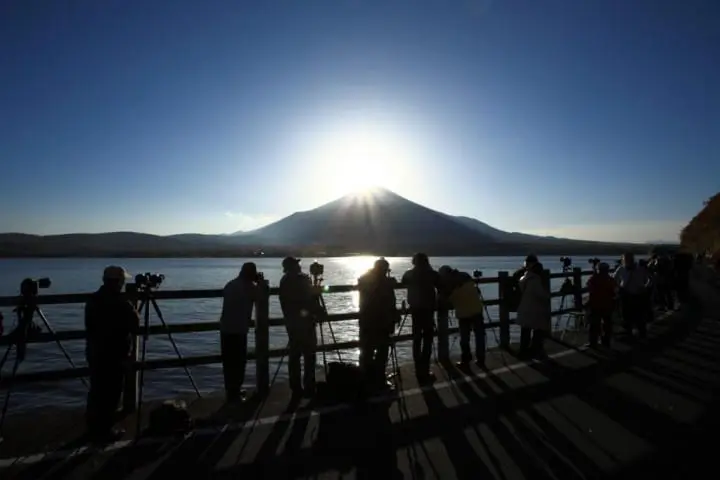
Picture courtesy of Yamanashi Tourism Organization
Yamanakako Shinsui Park (Nagaike Water Park), located on the lake's north side, is well-known as a Mt. Fuji lookout spot. The highlight is the sight of a majestic Mt. Fuji towering over the lakeside area.
Visitors will get to see Upside-Down Fuji, the reflection of the mountain on the lake's surface, and Double Diamond Fuji, the sight of the rising or setting sun directly over the mountain, reflecting off the water. These unique views draw many photographers.
*Double Diamond Fuji is visible during mid-November and mid-February.
Access: Take the sightseeing bus (Fujikko) and get off at Nagaikei Shinsui Koen Mae bus stop.
↑ Return to the top of article.
2. Go on a Scenic Mt. Fuji Cruise
One way of enjoying the lake is by a cruise. Lake Yamanakako has uniquely shaped boats from which passengers can enjoy views of Mt. Fuji. The two cruises listed are highly recommended.
Lake Yamanakako Pleasure Boat - "Swan Lake"
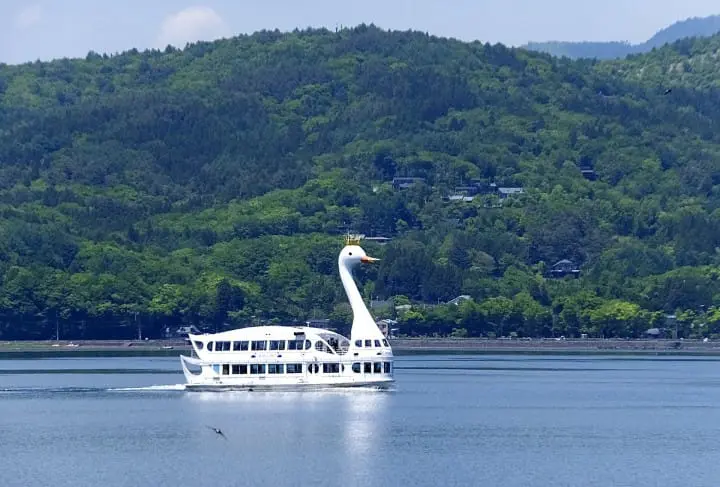
Board the Lake Yamanakako Pleasure Boat - "Swan Lake" to enjoy a leisurely cruise aboard a swan-shaped boat.
The boat's interior has a warm wood-grain color scheme. To enhance your voyage, there are some creative twists such as binoculars on stand-by in various locations and children's seating that comes equipped with handles.
The on-deck seating is popular and allows riders to catch the pleasant lake breeze.
You can board the boat on the lake's south side at the Asahigaoka Sanbashi Noriba or at the Yamanaka Sanbashi Noriba on the west side of the lake.
Location: Asahigaoka Sanbashi Noriba (1 minute on foot from Asahigaoka bus terminal), Yamanaka Sanbashi Noriba (1 minute on foot from the sightseeing boat terminal bus stop).
Cost: Adults 1,000 yen, Children 500 yen.
Boat service: 9:30-17:30, runs every 30 minutes (can change depending on season).
Time required: 25 minutes to circle the lake once.
Yamanakako no Kaba
With its unique eye-catching shape, Yamanakako no Kaba is a water bus that operates on the lake.
The moment the bus first slides into the water is exhilarating. Riders will be very impressed by the resulting water sprays. The windows can be opened, giving passengers a spacious, open kind of feeling.
You can board the bus at the Yamanakako Asahigaoka bus terminal on the south side of Lake Yamanakako.
Location: Yamanakako Asahigaoka bus terminal
Cost: Adults 2,300 yen (2,500 yen in summer), Children 1,150 yen (1,250 yen in summer).
Boat service: 9:00-16:00, runs every 45 minutes (can change depending on season)
Required time: 45 minutes to circle the lake once.
3. Oshino Hakkai - A World Heritage Site

Oshino Hakkai is a tourist spot on the south side of Lake Yamanakako.There are walking trails near the eight ponds in the area, which originate from Mt. Fuji's spring water.
The collection of ponds is designated a World Cultural Heritage Site, having fulfilled the constituent elements of being a sacred place and a source of artistic inspiration.
Visitors can enjoy watching the spring water gushing up from the bottom of the ponds. There are also shops selling souvenirs, and tofu and soba made with fresh spring water.
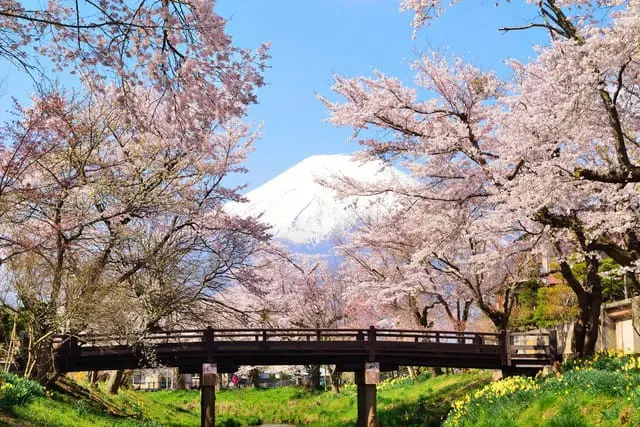
Photo by Pixta
Here in the springtime, you can take a photo that captures the cherry blossoms, Mt. Fuji, and the stunning lake in one shot.
Access to Oshino Hakkai from Lake Yamanakako is possible via route bus (15 minutes from the sightseeing boat terminal).
Hotels near Oshino Hakkai
Oshino Shinobi no Sato Ninja Village
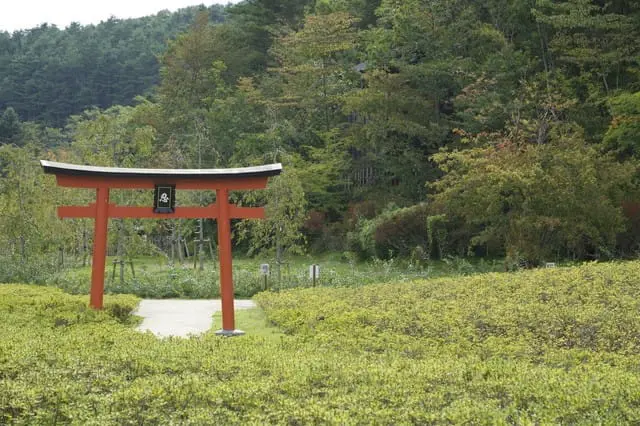
Photo by Pixta
Not far from Oshino Hakkai is Oshino Shinobi no Sato, a theme park where visitors can experience being a ninja for a day.
Here you can fully enjoy ninja culture, set against the background of an undeveloped woodland area. There are acrobatic ninja performances to watch, and dressed up in full ninja gear, you can try using a throwing star (shuriken) and participate in some athletic challenges.
Hotels near Oshino Shinobi no Sato
Cost (admission free pass): Adults 1,800 yen, Children 1,300 yen.
Business hours: 9:00-17:00 (can change depending on the season).
Access: Take the Loop bus and get off at Oshino Shinobi no Sato bus stop (about 20 minutes away from the sightseeing boat terminal).
↑ Return to the top of article.
4. Go for a Leisurely Bike Ride Along the Lake
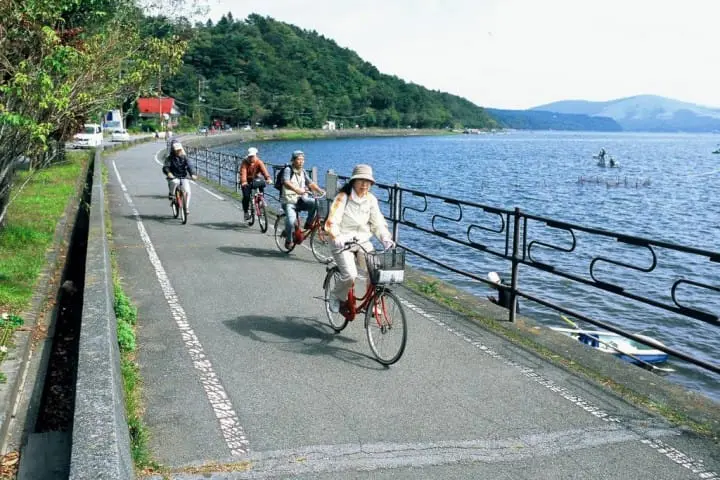
Picture courtesy of Yamanashi Tourism Organization
For those who would like to have an active outdoor experience, we suggest bicycling along the lake's shoreline. This route is fourteen kilometers in length and takes about ninety minutes to complete. A portion of the route is a paved cycling road.
Along the route, there are plenty of places to stop and take a break such as Yamanakako Bungaku no Mori Park, Asahigaoka Lakeside Parkland, Yamanakako Koryu Plaza Kirara, and Mama no Mori Miharashidai (lookout spot).
Near the lake, there are a handful of shops where you can rent a bicycle.
There's Yamanakako Jupiter (near the sightseeing boat terminal), Yamanakako Marine House momo (near the sightseeing boat terminal), Komeisou Marina (near the Lake Yamanakako village office), and also Yamanakako Drive Center (near Asahigaoka bus terminal). (The websites are in Japanese.)
↑ Return to the top of article.
5. Take a Dip in Mt. Fuji's Hot Springs
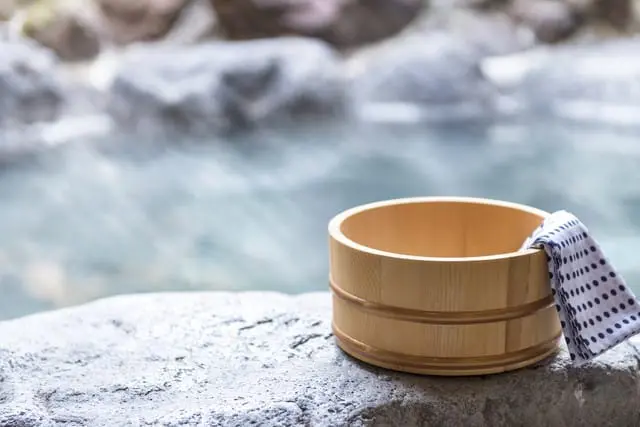
Photo by Pixta
Soak in an onsen (hot spring) to lessen your travel fatigue at the end of the day. There are many hot spring facilities and ryokans non-guests can use. You can admire Mt. Fuji's scenery as you relax in the bath.
Ishiwari no Yu (Japanese), located on the lake's east side, is a hot spring where wood and rock give you a warm feeling and the highly alkaline water is soothing and gentle to the skin.
At Benifuji no Yu and Hotel Mount Fuji, the large bath and rotemburo (outdoor bath) offer outstanding views of Mt. Fuji and the lake area.
Spend some well deserved luxurious time here.
Hotels near Hotel Mount Fuji
↑ Return to the top of article.
6. Let Yamanakako Hananomiyako Park Take Your Breath Away
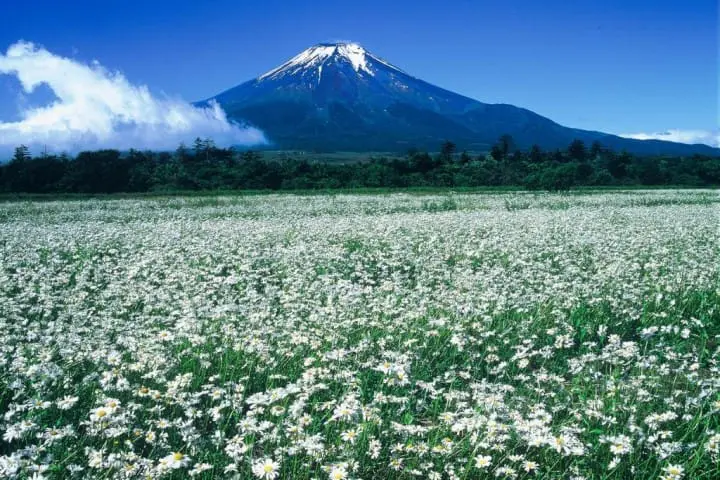
Picture courtesy of Yamanashi Tourism Organization
At Yamanakako Hananomiyako Park on Lake Yamanakako's west side, visitors can take in the scenery of Mt. Fuji and seasonal flowers covering the park's vast grounds.
The park grounds are divided into two sections; the flower garden and farm area (free admission), and Seiryu no Sato, an area where you can see gently-flowing waterfalls and a flower dome (admission required).

Photo by Pixta
Of course, the best time to see the flowers is when they're in full bloom. In April and May, tulips and baby blue eyes (nemophila) make their appearance, the poppies arrive in June and July. In August you can see the vibrant sunflowers, and from early summer until autumn the zinnia and cosmos flowers take center stage.
Be sure to take lots of pictures of the flowers and Mt. Fuji and relax with delicious soft-serve ice cream from the food stalls after the photography session.
Hotels near Lake Yamanaka Flower City Park
Open season: April 16 - October 15: 8:30 -17:30, October 16 - April 15: 9:00-16:30
Access: Take a sightseeing bus or route bus and get off at Hananomiyako-Koen bus stop.
↑ Return to the top of article.
7. Visit Local Art Galleries
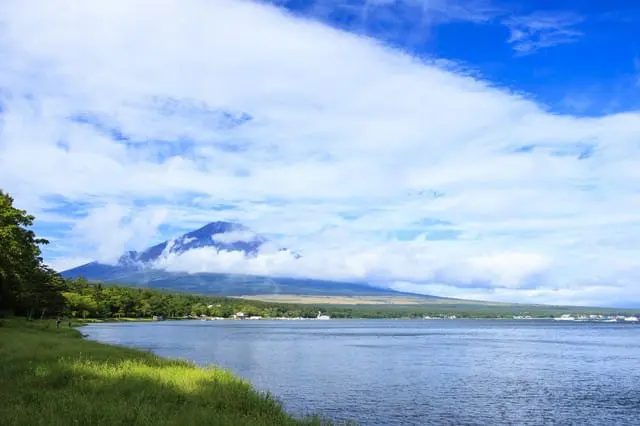
Photo by Pixta
Lake Yamanakako is filled with impressive natural scenery but also has art galleries, museums, and other cultural spots.
TheYamanakako Teddy Bear World Museum (Japanese) features a collection of teddy bears from around the world amidst a warm, at-home kind of atmosphere. It is on the south shore of the lake.
Another lakeside spot is the Santa Claus Museum in YAMANAKAKO (Japanese) where you can feel the festive spirit all year round.
Here you can see a wide variety of Santa Claus dolls and Christmas-related art objects.
In addition, there's also the Mishima Yukio Literary Museum, which displays the written works and historical documents of this famous Japanese writer.
↑ Return to the top of article.
8. Savor the Taste of Yamanashi's Gourmet Food
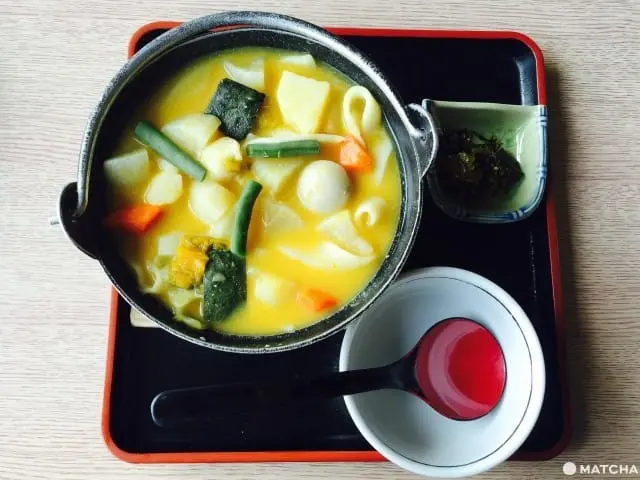
The Lake Yamanakako area is home to a wide range of eating establishments. Here there are casual eateries serving homestyle dishes and sophisticated cafes and restaurants.
Kosaku Yamanakako, features a Yamanashi specialty called hoto, flat, udon-like noodles. It is a famous restaraunt where you can sample a variety of local dishes.
Also recommended is Watanabe Udon, a popular restaurant that serves the Five Lakes' specialty dish, Yoshida Udon.
Just a short distance from the lake is a shop called Tenshoan where you can eat soba (buckwheat noodles) made using delicious water.
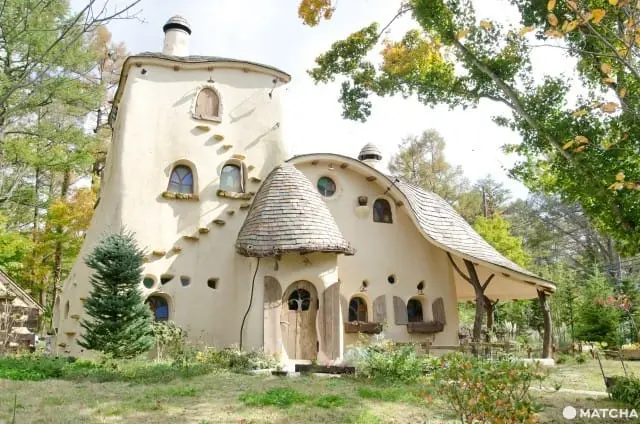
PAPER MOON is a shop that serves flavorful homemade cakes. The shop has a stylish interior and is surrounded by a beautiful garden.
Visitors can enjoy pasta and other meal sets at Mori no Alm, a restaurant set inside a fantasy-filled building.
↑ Return to the top of article.
Getting to Lake Yamanakako from Tokyo and Lake Kawaguchiko
Next we'll explain how to get to Lake Yamanakako from Tokyo and Lake Kawaguchiko.
Access from Tokyo
When leaving from the greater Tokyo area, a direct highway bus is very convenient.
At Busta Shinjuku, the highway bus terminal beside Shinjuku Station, get on a bus headed for Shinjuku-Fuji Goko and get off at Mt. Fuji-Lake Yamanakako.
The travel time is 2 hours and 15 minutes-30 minutes, and the one-way fare is 2,000 yen.
Access from the Lake Kawaguchiko Area
When departing from Lake Kawaguchiko or Fuji-Q Highland, the sightseeing Fujikko Bus is convenient.
To get from Kawaguchiko Ekimae bus stop to Mt. Fuji-Lake Yamanakako takes about fifty minutes. The one-way fare is 630 yen. There's also a Two Day All-You-Can-Ride Free Coupon that sells for 1,500 yen (for one adult).
↑ Return to the top of article.
Hotels in the Lake Yamanakako Area
Lake Yamanakako has many hotels, guesthouses, and other lodgings to accommodate its many visitors.
For example, the Marriot Fuji Lake Yamanaka, a hotel nestled quietly amongst a grove of trees, offers refined and sophisticated guest rooms. Also recommended is PICA Yamanakako Village, a cottage-style accommodation where you can enjoy the great outdoors.
SANU 2nd Home Yamanakako 1st
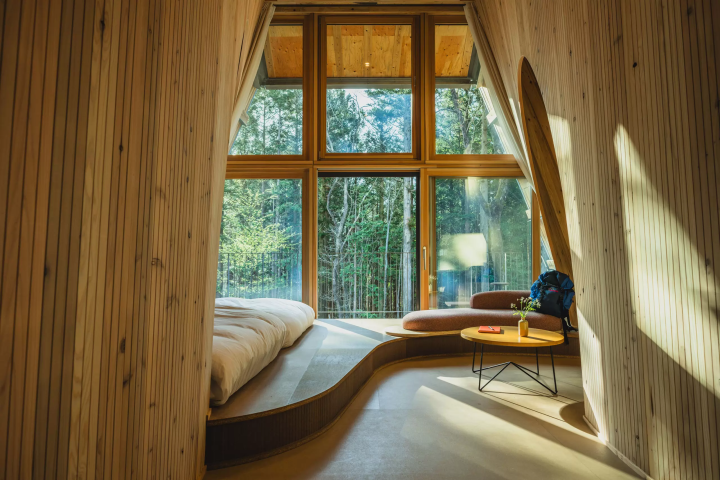
Picture courtesy of SANU Inc.
For a truly memorable stay, we recommend SANU 2nd Home Yamanakako 1st, a vacation villa that you can rent from one night to as many days as you wish.
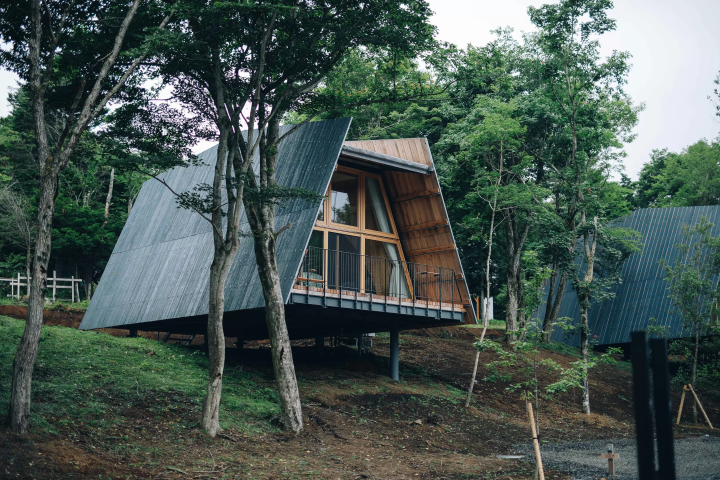
Picture courtesy of SANU Inc.
SANU 2nd Home Yamanakako 1st is a BEE-type villa featuring a unique exterior inspired by a honeycomb, along with an open, spacious interior with a ceiling height of approximately 4 meters.
Its large windows offer beautiful views of nature, making it a standalone cabin with a charming appeal. Previous guests have highly rated the facility, saying that it was exceptional, well-equipped, and beautifully designed.
SANU 2nd Home is perfect for those seeking an experience of "living like locals" while staying immersed in Japan’s natural environment.
Weather and Climate
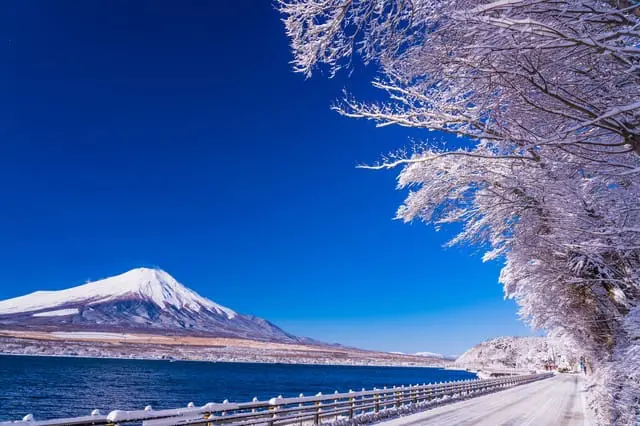
Photo by Pixta
Within the Fuji Goko (Fuji Five Lakes) region, Lake Yamanakako sits at the highest elevation with an altitude of 1,000 meters.
Due to its high elevation, it tends to have a cool climate throughout the year. Even in the middle of summer, the average temperature hovers around the 20°C mark, and in the winter it drops down below 0°C.
For summer clothing we recommend bringing a long-sleeved jacket to combat the chilly mornings and evenings and to offer UV sun protection.
For the fall and winter season, it's best to bring a down jacket or heavy coat, gloves, and a wool cap, to fight off the cold. Roads often freeze over so for footwear we recommend non-slip boots.
FAQ
Is Lake Yamanaka worth visiting?
Lake Yamanaka, situated near Mount Fuji in Japan, is a destination well worth visiting for its scenic beauty and varied attractions. Offering breathtaking views of Mount Fuji reflected in its waters, the lake provides a picturesque backdrop throughout the year, inviting visitors to capture the iconic mountain's splendor. Outdoor enthusiasts can partake in activities like fishing, boating, and lakeside picnics, while onsen resorts around the lake offer relaxation opportunities in natural hot springs. Cultural sites, including historic shrines and temples, add cultural depth to the area, complementing its natural charm. With family-friendly attractions, walking trails, and parks for leisurely exploration, Lake Yamanaka presents a diverse range of experiences appealing to nature lovers, adventure seekers, and those looking to unwind amidst the scenic beauty of Japan's Fuji Five Lakes region.
How do I get from Tokyo to Mount Fuji?
Traveling from Tokyo to Mount Fuji presents several transportation options for a convenient journey to Japan's iconic landmark. Taking the JR Tokaido Shinkansen from Tokyo Station to Mishima or Shin-Fuji Stations and then transferring to local trains or buses is a fast and efficient way to reach Mount Fuji. For a direct route, highway buses departing from Shinjuku and Shibuya in Tokyo provide convenient access to Mount Fuji's 5th Station. Alternatively, driving with a rental car allows flexibility and exploration of the area, with highways enabling easy access to Mount Fuji and designated parking areas. Joining organized tours from Tokyo to Mount Fuji offers hassle-free experiences with transportation, activities, and expert guidance included. These varied options cater to different preferences and travel styles, ensuring a memorable and enjoyable excursion to Mount Fuji from Tokyo.
Where is the closest place to see Mount Fuji in Tokyo?
While Mount Fuji is not typically visible from central Tokyo due to the city's urban landscape and distance from the mountain, there are select spots within the city offering distant views of the iconic peak on exceptionally clear days. The observation decks at the Tokyo Metropolitan Government Building in Shinjuku provide a chance to catch glimpses of Mount Fuji from afar, particularly from the South Observation Deck when visibility conditions permit. For a closer and more scenic view of Mount Fuji, travelers are encouraged to venture outside of Tokyo to locations like Hakone, Kawaguchiko, or the Fuji Five Lakes region, where the majestic mountain is more prominently visible and offers stunning vistas that showcase its natural beauty and grandeur.
How do I get to Yamanaka Lake from Tokyo?
Traveling from Tokyo to Yamanaka Lake near Mount Fuji offers various transportation options for a scenic journey to the Fuji Five Lakes region. One common route is by train and bus, starting with the JR Chuo Line from Tokyo Station to Otsuki Station, followed by transferring to the Fujikyu Railway for a limited express train to Kawaguchiko Station. From Kawaguchiko Station, a local bus can take you to Yamanakako Asahigaoka or Yamanakako Post Office near Yamanaka Lake. Alternatively, direct highway buses operate from Shinjuku Expressway Bus Terminal in Tokyo to Yamanakako Asahigaoka bus stop, offering a convenient 2.5 to 3-hour journey. For those driving, the approximately 1.5 to 2-hour trip by car from Tokyo to Yamanaka Lake via highways provides flexibility and access to the natural beauty of the Fuji Five Lakes region, promising a memorable and picturesque excursion from Tokyo to Yamanaka Lake.
Where to explore near Mount Fuji?
Exploring the areas near Mount Fuji reveals a treasure trove of natural beauty, cultural richness, and outdoor adventures. The Fuji Five Lakes region, including Lake Kawaguchi and Lake Yamanaka, offers mesmerizing views of Mount Fuji, with opportunities for boating and hiking in serene surroundings. The Chureito Pagoda in Fujiyoshida presents a postcard-worthy vista of the mountain framed by cherry blossoms and autumn foliage. Hakone, a renowned hot spring resort town, showcases scenic landscapes, hot springs, and views of Mount Fuji from Lake Ashi, along with activities like cable car rides and boat cruises. Oshino Hakkai charms visitors with its eight crystal-clear ponds and traditional houses, providing a tranquil escape. Shopaholics can indulge in retail therapy at the Gotemba Premium Outlets near Mount Fuji, while nature lovers can visit Shiraito Falls and Otodome Falls, serene cascades perfect for leisurely walks and picnics. Exploring these diverse destinations near Mount Fuji promises an enriching blend of natural wonders, cultural heritage, and outdoor experiences that capture the essence of this iconic Japanese landmark.
How long does it take to walk around Lake Yamanaka?
Walking around Lake Yamanaka near Mount Fuji, which has a circumference of approximately 13 kilometers (8 miles), typically takes around 3 to 4 hours at a leisurely pace. This estimate allows for a moderate walk with occasional stops to appreciate the scenic beauty of the lake, rest, and explore points of interest along the way. Visitors looking to stroll around Lake Yamanaka should consider their fitness level, walking speed, and any additional time needed for breaks, photos, or detours to fully immerse themselves in the natural splendor of the Fuji Five Lakes region and enjoy the tranquil ambiance surrounding the lake.
Where to see swans at Lake Yamanaka?
Lake Yamanaka offers several prime spots for observing swans, particularly during the winter months when these elegant birds migrate to the area. Yamanakako Swan Park presents a designated area along the lake's shoreline where visitors can witness swans gathering and interacting in their natural habitat, with opportunities for feeding experiences and close-up views. The Miharashi Hill Observation Deck provides a panoramic vista of Lake Yamanaka, serving as an elevated viewpoint for observing swans gracefully navigating the waters. Additionally, taking a leisurely lakeside stroll allows for peaceful encounters with swans gliding and resting along the lake's edge, offering nature enthusiasts and birdwatchers a tranquil experience amidst the scenic beauty of the Fuji Five Lakes region.
Visit Lake Yamanakako
The possibilities are endless when it comes to having fun at Lake Yamanakako. There are cycling courses and cruises offering breathtaking views of Mt. Fuji, relaxing hot springs, and art museum tours.
Use this article as a reference for how to experience the gorgeous Lake Yamanakako area for yourself.
Main image by Pixta
Born in Yamagata Prefecture. I have experience working in community development at the foot of Mt. Fuji and PR for local products across the country, and am currently working in Tokyo to disseminate information about Yamanashi Prefecture. A mother of one who loves local gourmet food and alcohol.






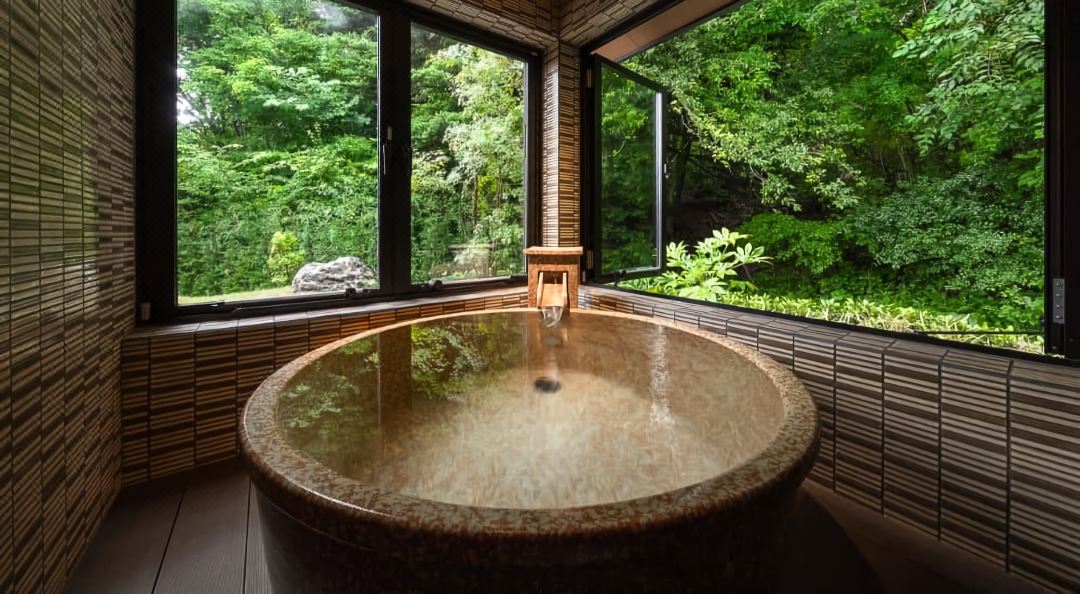

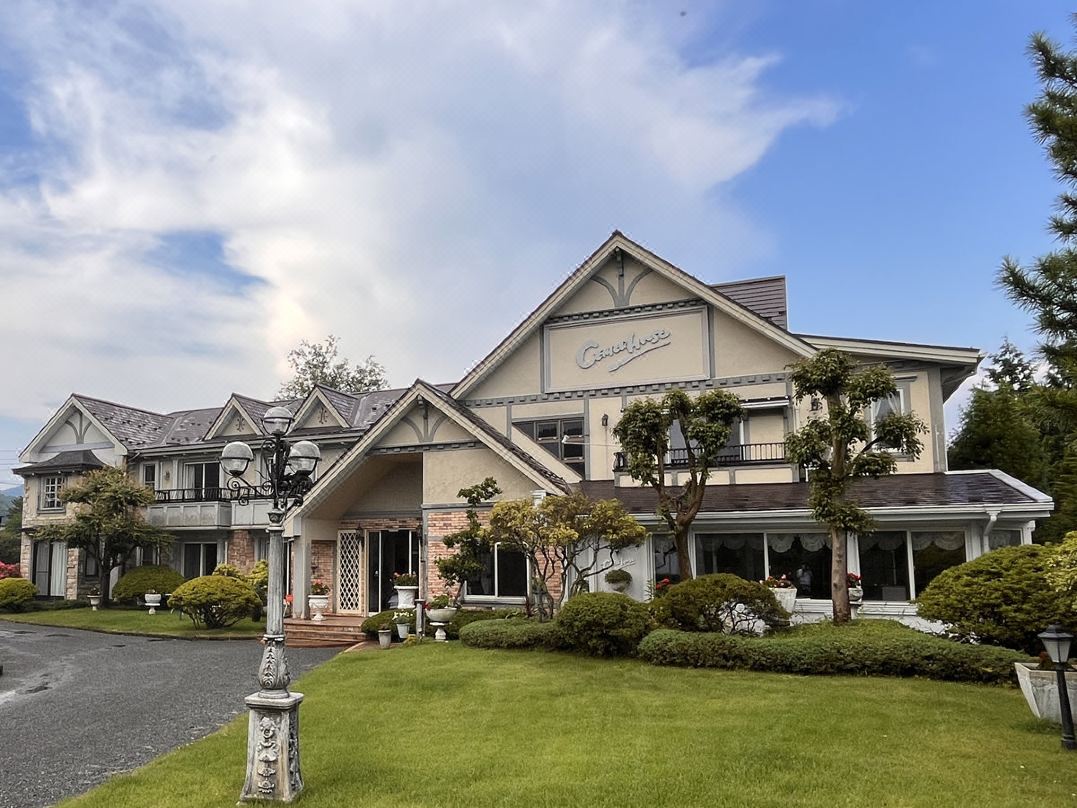



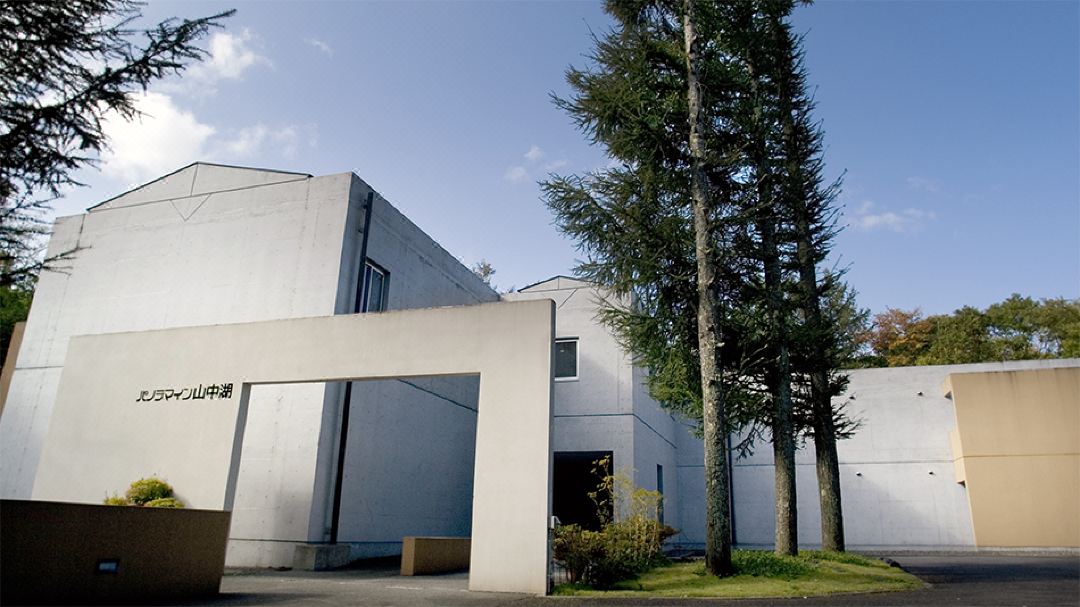
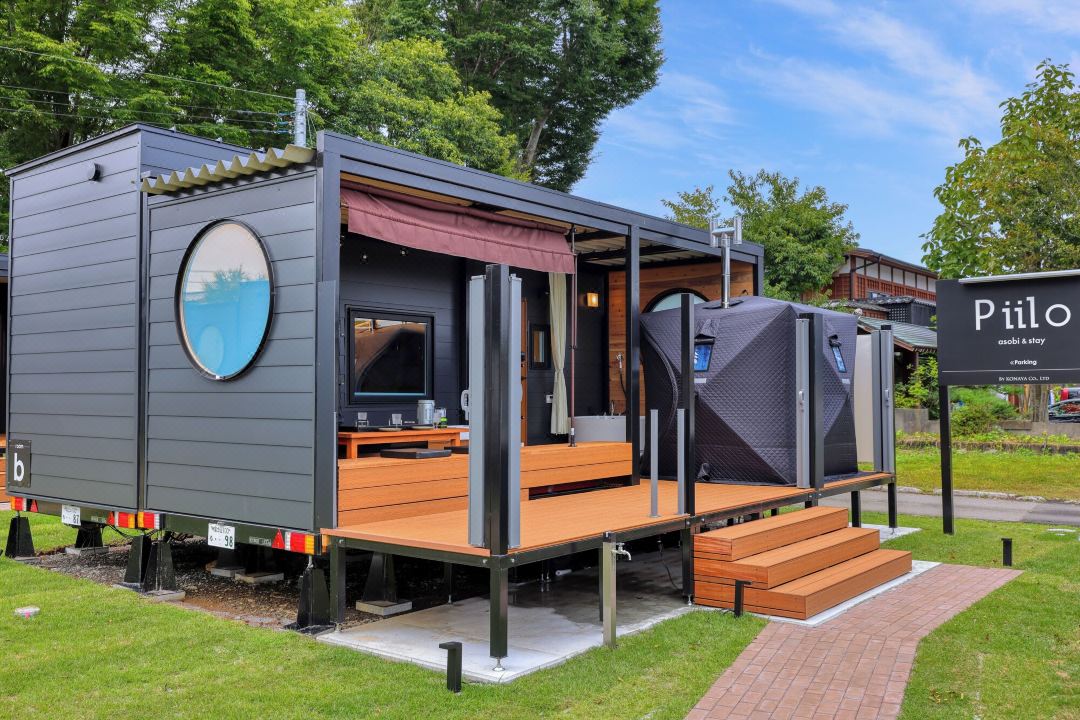

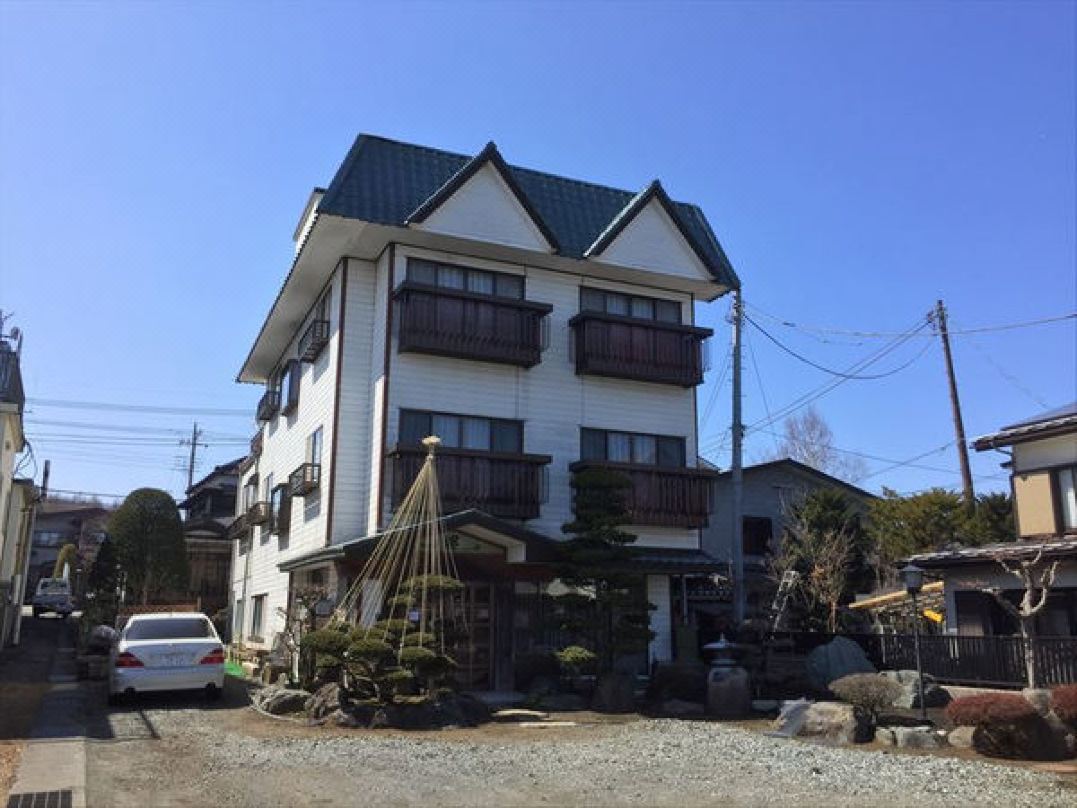
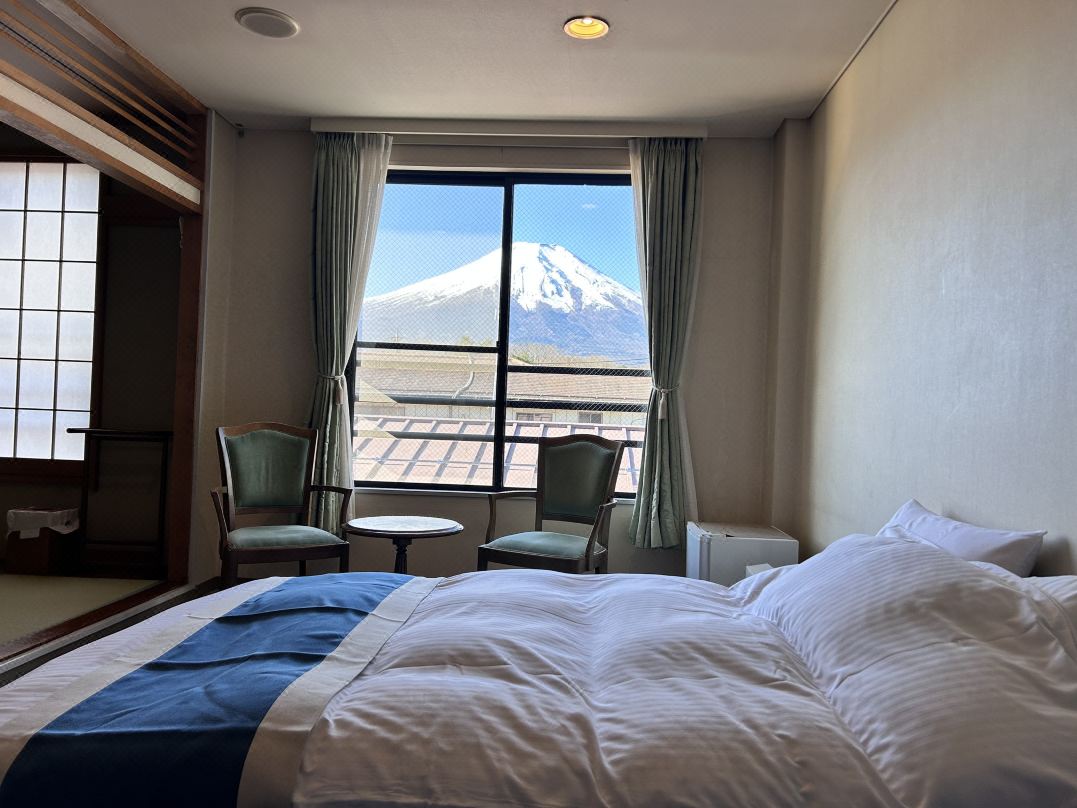






































![[JR KYUSHU HOTEL Blossom Oita] A hotel directly connected to Oita Station - A comprehensive guide to access!](https://resources.matcha-jp.com/resize/720x2000/2025/10/23-247814.webp)
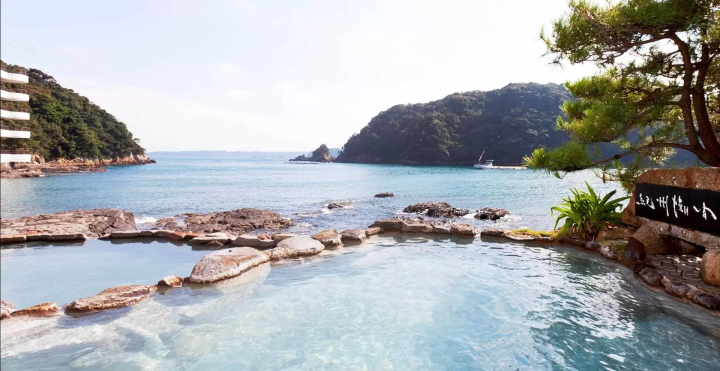
![Deep dive into Japanese brands! A tour of famous leather shoe stores with GENSEI & Nin [Harta Edition]](https://resources.matcha-jp.com/resize/720x2000/2025/12/18-253277.webp)
